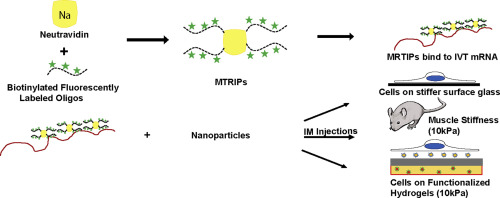Biomaterials ( IF 14.0 ) Pub Date : 2018-01-06 , DOI: 10.1016/j.biomaterials.2018.01.010 Sushma M. Bhosle , Kristin H. Loomis , Jonathan L. Kirschman , Emmeline L. Blanchard , Daryll A. Vanover , Chiara Zurla , Damien Habrant , Darin Edwards , Patrick Baumhof , Bruno Pitard , Philip J. Santangelo

|
The translational efficiency of an in vitro transcribed (IVT) mRNA was measured upon delivery to primary skeletal muscle cells and to a mouse model system, towards the development of a predictive in vitro assay for the screening and validation of intramuscular mRNA-based vaccines. When IVT mRNA was delivered either naked or complexed with novel aminoglycoside-based delivery vehicles, significant differences in protein expression in vitro and in vivo were observed. We hypothesized that this previously anticipated discrepancy was due to differences in the mechanism of IVT mRNA endosomal entry and release following delivery. To address this, IVT mRNA was fluorescently labeled prior to delivery, to visualize its distribution. Colocalization with endosomal markers indicated that different entry pathways were utilized in vivo and in vitro, depending on the delivery vehicle, resulting in variations in protein expression levels. Since extracellular matrix stiffness (ECM) influences mRNA entry, trafficking and release, the effect of mechanotransduction on mRNA expression was investigated in vitro upon delivery of IVT mRNA alone, and complexed with delivery vehicles to skeletal muscle cells grown on ∼10 kPa hydrogels. This in vitro hydrogel model more accurately recapitulated the results obtained in vivo upon IM injection, indicating that this approach may assist in the characterization of mRNA based vaccines.
中文翻译:

通过机械转导来统一骨骼肌的体外和体内IVT mRNA表达差异
体外转录(IVT)mRNA的翻译效率是在交付至初级骨骼肌细胞和小鼠模型系统后进行测量的,以开发用于筛选和验证基于肌内mRNA的疫苗的预测性体外分析方法。当IVT mRNA裸递送或与新型基于氨基糖苷的递送载体复合时,体外和体内蛋白质表达的显着差异被观察。我们假设,这种先前预期的差异是由于IVT mRNA内体进入和释放后释放的机制不同所致。为了解决这个问题,IVT mRNA在交付前被荧光标记,以可视化其分布。与内体标记的共定位表明,取决于递送载体,体内和体外利用了不同的进入途径,导致蛋白质表达水平的变化。由于细胞外基质硬度(ECM)影响mRNA的进入,运输和释放,因此在体外研究了机械转导对mRNA表达的影响。单独递送IVT mRNA后,与递送载体复合至在约10 kPa水凝胶上生长的骨骼肌细胞。这种体外水凝胶模型更准确地概括了IM注射后在体内获得的结果,表明该方法可能有助于表征基于mRNA的疫苗。


























 京公网安备 11010802027423号
京公网安备 11010802027423号